In the crowded compact SUV market, the Suzuki Vitara and VW T-Roc emerge as two attractive options, each with its unique strengths and characteristics. This article delves into a detailed comparison of these two models, focusing on their technical aspects, performance, and innovations to help you decide which vehicle might suit your needs better.
Suzuki Vitara vs VW T-Roc – Performance, range & efficiency compared
Everyday use, family trips or long-distance drives – here’s where the differences show.
Discover whether Suzuki Vitara or VW T-Roc fits your lifestyle better.
Design and Dimensions
The Suzuki Vitara, with its sturdy and rugged design, measures 4185 mm in length, 1775 mm in width, and stands 1595 mm tall. It presents a balanced, aggressive stance that appeals to adventurers and city-dwellers alike. The payload capacity ranges from 375 kg to 395 kg, reflecting its practicality.
On the other hand, the VW T-Roc is slightly larger, showcasing a more modern aesthetic with its sharp lines and distinctive rear. The T-Roc stretches from 4236 mm to 4271 mm in length, and its width varies between 1811 mm and 1819 mm, while the height ranges from 1527 mm to 1584 mm. The T-Roc also boasts a higher trunk capacity of up to 445 liters, making it a more spacious option for those who prioritize cargo space.
Engine Options and Performance
Under the hood, the Suzuki Vitara offers a choice of petrol engine options, including a 1.4-liter MHEV engine that produces up to 129 HP and a full hybrid variant. The Vitara features both manual and automated manual transmissions, providing flexibility for drivers. In terms of acceleration, the Vitara can go from 0-100 km/h in as little as 9.5 seconds, and it achieves a decent top speed of 190 km/h. Fuel efficiency is commendable too, with consumption figures ranging from 5 to 5.6 L/100 km.
In contrast, the VW T-Roc provides a broader spectrum of engine choices, ranging from efficient petrol engines to powerful diesel options. Engine outputs can go up to an impressive 300 HP, with the more powerful variants capable of a dynamic 0-100 km/h sprint in just 4.9 seconds. The T-Roc also offers both manual and dual-clutch automatic transmissions, enhancing the driving experience. Fuel consumption varies more widely, from as low as 4.7 L/100 km to 8.5 L/100 km, depending on the variant selected.
Drive Options and Handling
Both the Suzuki Vitara and VW T-Roc provide front-wheel drive and all-wheel drive options, catering to different driving preferences and conditions. The Vitara's all-wheel drive is particularly commendable for off-road capabilities, reflecting its SUV heritage. The T-Roc, on the other hand, leans towards a more on-road driving experience, with its sporty dynamics further accentuated by its optional performance features.
Technological Innovations
In terms of technology, the Suzuki Vitara comes equipped with a user-friendly infotainment system with smartphone integration, ensuring that drivers stay connected while on the road. The 2024 model also introduces safety features such as advanced driver-assist systems that enhance overall security.
The VW T-Roc raises the bar with its tech offerings. It features an intuitive digital cockpit that encapsulates modern infotainment standards and customizable display options. Additionally, advanced safety techniques and driving aids such as adaptive cruise control and lane assist make the T-Roc a more tech-savvy choice.
Conclusion: Which SUV Should You Choose?
Ultimately, the decision between the Suzuki Vitara and VW T-Roc will depend on individual preferences and priorities. If you are looking for a rugged, practical SUV that excels in fuel efficiency and offers good off-road capabilities, the Vitara is an excellent choice. However, if you desire a more technologically advanced vehicle with a modern design and superior performance options, the T-Roc stands out.
Both models deliver reliable performance and comfort, making them worthy contenders in the compact SUV segment. Consider your needs and desires carefully to determine which vehicle will provide the best driving experience for you.
Here’s where it gets real: The technical differences in detail
Costs and Efficiency:
Price and efficiency are often the first things buyers look at. Here it becomes clear which model has the long-term edge – whether at the pump, the plug, or in purchase price.
Suzuki Vitara has a slightly advantage in terms of price – it starts at 23600 £, while the VW T-Roc costs 26400 £. That’s a price difference of around 2867 £.
Fuel consumption also shows a difference: Suzuki Vitara manages with 5 L and is therefore slight more efficient than the VW T-Roc with 5.50 L. The difference is about 0.50 L per 100 km.
Engine and Performance:
Power, torque and acceleration are the classic benchmarks for car enthusiasts – and here, some clear differences start to show.
When it comes to engine power, the VW T-Roc has a to a small extent edge – offering 150 HP compared to 129 HP. That’s roughly 21 HP more horsepower.
In acceleration from 0 to 100 km/h, the VW T-Roc is minimal quicker – completing the sprint in 8.90 s, while the Suzuki Vitara takes 9.50 s. That’s about 0.60 s faster.
In terms of top speed, the VW T-Roc performs slightly better – reaching 212 km/h, while the Suzuki Vitara tops out at 190 km/h. The difference is around 22 km/h.
There’s also a difference in torque: VW T-Roc pulls minimal stronger with 250 Nm compared to 235 Nm. That’s about 15 Nm difference.
Space and Everyday Use:
Cabin size, boot volume and payload all play a role in everyday practicality. Here, comfort and flexibility make the difference.
Both vehicles offer seating for 5 people.
In curb weight, Suzuki Vitara is somewhat lighter – 1255 kg compared to 1465 kg. The difference is around 210 kg.
In terms of boot space, the VW T-Roc offers noticeable more room – 475 L compared to 375 L. That’s a difference of about 100 L.
In maximum load capacity, the VW T-Roc performs slightly better – up to 1350 L, which is about 230 L more than the Suzuki Vitara.
When it comes to payload, VW T-Roc noticeable takes the win – 515 kg compared to 400 kg. That’s a difference of about 115 kg.
Who wins the race?
The VW T-Roc proves to be dominates this comparison and therefore becomes our DriveDuel Champion!
VW T-Roc is the better all-rounder in this comparison.
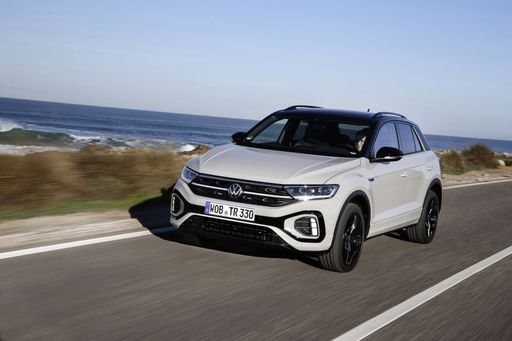 @ Volkswagen AG / VW Media
@ Volkswagen AG / VW Media
VW T-Roc
Suzuki Vitara
The Vitara is a city-smart SUV with a cheeky streak of off-road promise, perfect for drivers who want practicality without pretense. It’s honest, easy to live with and surprisingly likeable, a sensible companion for everyday adventures and weekend escapes.
details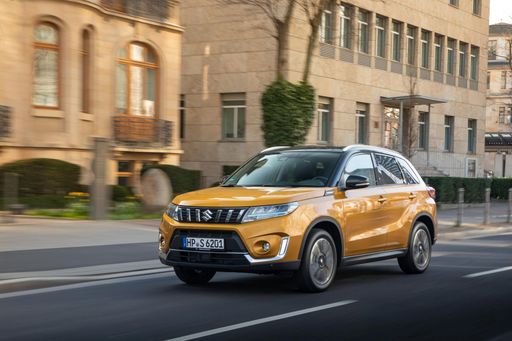 @ Suzuki Motor Corporation
@ Suzuki Motor Corporation
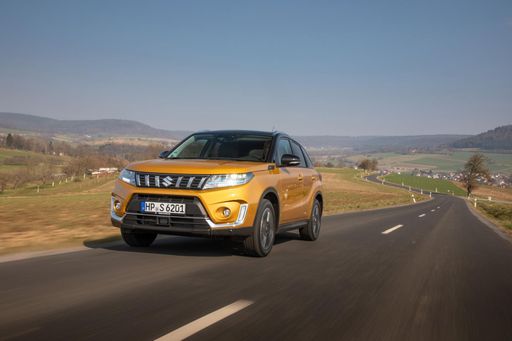 @ Suzuki Motor Corporation
@ Suzuki Motor Corporation
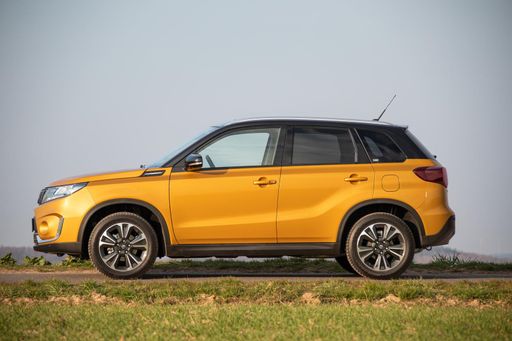 @ Suzuki Motor Corporation
@ Suzuki Motor Corporation
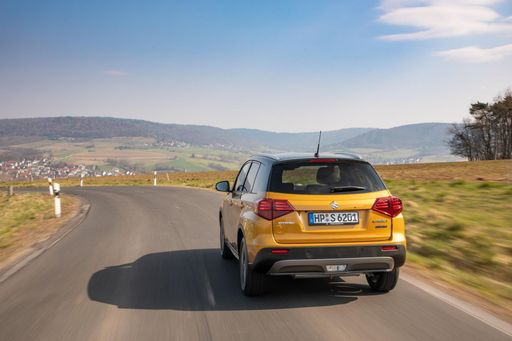 @ Suzuki Motor Corporation
@ Suzuki Motor Corporation
 @ Suzuki Motor Corporation
@ Suzuki Motor Corporation
 @ Suzuki Motor Corporation
@ Suzuki Motor Corporation
VW T-Roc
The VW T-Roc mixes cheeky, coupe-like styling with the everyday sense and space of an SUV, so it looks fun without sacrificing family sense. It’s a likeable all-rounder with tidy road manners and plenty of personality, ideal if you want a car that’s practical enough for chores but entertaining enough to enjoy.
details @ Volkswagen AG / VW Media
@ Volkswagen AG / VW Media
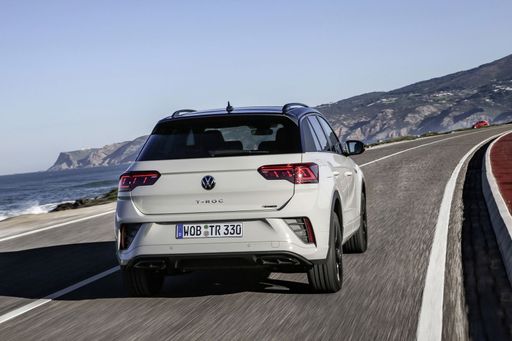 @ Volkswagen AG / VW Media
@ Volkswagen AG / VW Media
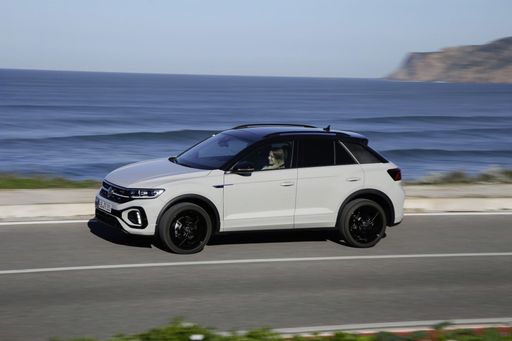 @ Volkswagen AG / VW Media
@ Volkswagen AG / VW Media
 @ Volkswagen AG / VW Media
@ Volkswagen AG / VW Media
 @ Suzuki Motor Corporation
@ Suzuki Motor Corporation
|
 @ Volkswagen AG / VW Media
@ Volkswagen AG / VW Media
|
|
|
|
Costs and Consumption |
|
|---|---|
|
Price
23600 - 30900 £
|
Price
26400 - 38000 £
|
|
Consumption L/100km
5 - 5.9 L
|
Consumption L/100km
5.5 - 6.3 L
|
|
Consumption kWh/100km
-
|
Consumption kWh/100km
-
|
|
Electric Range
-
|
Electric Range
-
|
|
Battery Capacity
-
|
Battery Capacity
-
|
|
co2
113 - 138 g/km
|
co2
126 - 143 g/km
|
|
Fuel tank capacity
47 L
|
Fuel tank capacity
50 L
|
Dimensions and Body |
|
|---|---|
|
Body Type
SUV
|
Body Type
SUV
|
|
Seats
5
|
Seats
4 - 5
|
|
Doors
5
|
Doors
2 - 5
|
|
Curb weight
1255 - 1395 kg
|
Curb weight
1465 - 1539 kg
|
|
Trunk capacity
289 - 375 L
|
Trunk capacity
284 - 475 L
|
|
Length
4185 mm
|
Length
4271 - 4373 mm
|
|
Width
1775 mm
|
Width
1811 - 1828 mm
|
|
Height
1595 mm
|
Height
1527 - 1573 mm
|
|
Max trunk capacity
1046 - 1120 L
|
Max trunk capacity
1350 L
|
|
Payload
375 - 400 kg
|
Payload
368 - 515 kg
|
Engine and Performance |
|
|---|---|
|
Engine Type
Petrol MHEV, Full Hybrid
|
Engine Type
Petrol, Petrol MHEV
|
|
Transmission
Manuel, Automatic
|
Transmission
Manuel, Automatic
|
|
Transmission Detail
Manual Gearbox, Automated Manual, Automatic Gearbox
|
Transmission Detail
Manual Gearbox, Dual-Clutch Automatic
|
|
Drive Type
Front-Wheel Drive, All-Wheel Drive
|
Drive Type
Front-Wheel Drive
|
|
Power HP
110 - 129 HP
|
Power HP
115 - 150 HP
|
|
Acceleration 0-100km/h
9.5 - 12.7 s
|
Acceleration 0-100km/h
8.9 - 12.3 s
|
|
Max Speed
180 - 190 km/h
|
Max Speed
187 - 212 km/h
|
|
Torque
235 Nm
|
Torque
200 - 250 Nm
|
|
Number of Cylinders
4
|
Number of Cylinders
3 - 4
|
|
Power kW
81 - 95 kW
|
Power kW
85 - 110 kW
|
|
Engine capacity
1373 - 1462 cm3
|
Engine capacity
999 - 1498 cm3
|
General |
|
|---|---|
|
Model Year
2024 - 2025
|
Model Year
2024 - 2025
|
|
CO2 Efficiency Class
D, C, E
|
CO2 Efficiency Class
E, D
|
|
Brand
Suzuki
|
Brand
VW
|
What drivetrain options does the Suzuki Vitara have?
Available configurations include Front-Wheel Drive or All-Wheel Drive.
The prices and data displayed are estimates based on German list prices and may vary by country. This information is not legally binding.
